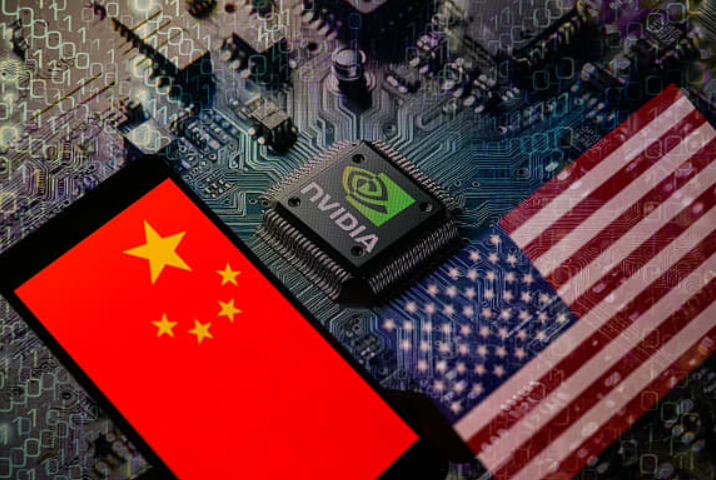
Huawei, Baidu, Alibaba and Tencent move to reduce external dependence and strengthen the National AI ecosystem
A new chapter in Technological War unfolds while China’s leading technology companies, such as Alibaba, Tencent, and Baidu, intensify their efforts to disentangle the development of artificial intelligence from the dependence of Nvidia processors. The urgency is palpable, driven by a smaller and smaller inventory of coveted US chips and a Washington regulatory tightening that redefines game rules in the global semiconductor market.
Also read: Ia Chinese follows his own way without Nvidia
In a strategic movement that can redesign AI’s future in the Asian country, China’s largest technological powers started a complex and potentially costly transition: adapt their ambitious artificial intelligence projects to operate with home manufacturing chips.
This initiative, which was already considered, has gained traction and urgency in the face of the growing scarcity of the American giant processors Nvidia and the discharge of the commercial sanctions imposed by the United States, aimed at curbing Chinese technological advancement.
Internal sources of the sector, familiar with giant operations, confirm that heavy names such as Alibaba Group Holding, Tencent Holdings and Baidu are already in an advanced phase of testing with alternative semiconductor. The goal is clear: to ensure the continuity and expansion of its AI solutions, both to meet the robust internal demand and to meet the needs of its vast portfolios of customer.
The pressure increased considerably after former President Donald Trump’s administration in one of his latest commercial offensives last month, intensifying restrictions on the sale of Nvidia’s H20 chip. This component, a reduced version, had been specifically developed by Nvidia to circumvent the export rules previously established during Joe Biden’s government, but also ended up sights on regulators.
The inventory situation is critical. Backstage information, obtained from sources with direct knowledge of the subject, indicates that current Nvidia chip reserves are sufficient to support the AI development rhythm of Chinese companies only by the beginning of next year.
Considering that new state -of -the -art requests can take three to six months to be processed and delivered – an already tight deadline – uncertainty about Nvidia’s ability to launch a processor that is both competitive and compatible with new and most rigorous US export rules puts Chinese companies in a real race against the clock.
In this emergency scenario, Shen Dou, who runs the Baidu cloud AI business group, one of the pioneers in artificial intelligence in China, expressed cautious optimism. He recently stated that the company has a varied range of chip options, especially for inference processing – a fundamental stage in the practical application of AI to solve specific problems – which can, in theory, replace NVIDIA components.
“We believe that over time, locally developed chips, combined with increasingly efficient software, will form a solid foundation for innovation in China’s AI ecosystem.”Shen declared, signaling a long -term bet on domestic innovation capacity.
The response of the giants was not expected. In recent public communications and appearances, the main executives of Chinese companies have signaled adjustments to their hardware acquisition and development strategies.
Eddie Wu, the Alibaba CEO, a conglomerate that covers from e -commerce to cloud services with intensive use of AI, stressed that the company is “Actively exploring diverse solutions to meet the growing demand of customers”. This statement suggests an opening for multiple suppliers and technologies, including those developed internally.
Similarly, Martin Lau, president of Tencent, another power with vast interests in games, social networks and cloud computing, said the company is in a continuous process of optimizing the use of its existing chips, while evaluating viable alternatives in the market.
“We have enough stock of high performance chips to train our models for some generations”Lau said, seeking to reassure the market for the training capacity of AI models, which require great computational power. He added, however, that Tencent can “Use other processors” To supply the growing demand for inference, a segment that has expanded rapidly with the popularization of AI applications in various sectors of the Chinese economy.
A recent report by an influential Think-Tank with calls with the China State Ministry of Security has brought an interesting perspective on the impact of sanctions. The document points out that although the restrictions imposed by the US are undoubtedly harmful in the short term, they paradoxically “They encouraged a wave of independent innovation on high -performance AI chips, with Huawei’s Ascend series as the main example.”. In fact, according to the China Institutes of Contemporary International Relations, several Chinese entities have already begun a large -scale adoption movement of the Huawei designed chips.
Initially, the main buyers of these processors were state -owned companies, such as China Mobile telecommunications giant, and strategic or sensitive sectors such as defense, health and the financial system. However, the expectation now is that a broader spectrum of technology companies, including large private sector, will play Huawei chips.
Nevertheless, a veil of caution hangs over this transition. Many companies avoid publicly commenting on their ascend processor adoption plans and plans, especially after the United States issued alerts that the use of these components “Anywhere in the world” It could result in criminal penalties, raising the risk associated with the bet on Huawei’s solution.
On Nvidia’s side, the situation is also delicate. The American company, an undisputed leader in the AI chip market, sees one of its biggest markets under severe restriction. GF Securities analysts project that Nvidia can start production of a new chip, compatible with the current US export rules around July.
However, this new processor, which would be based on the company’s latest Blackwell architecture, will probably not feature high bandwidth memory (HBM), a crucial component for agile large data volume processing, essential for complex AI tasks.
In addition, fundamental details such as the inclusion of NVLINK technology – used to establish very high speed connections between multiple chips, optimizing parallel workload performance – still remain uncertain.
In a recent conference, Jensen Huang, the charismatic NVIDIA CEO, openly admitted the difficulties faced by the company to serve the Chinese market under the new guidelines. His statement was direct and somewhat discouraging for local customers: “At the moment, we have nothing”he said, underlining the absence of a definitive and immediate solution.
The transition to local manufacturing chips is far from a simple or painless task. Adapt the AI Model Training Codes, mostly developed for Nvidia’s Cuda Platform – a widely dominant software and hardware ecosystem in the industry – for Huawei’s Framework, for example, is an intrinsically long process that requires intensive engineering team support.
These professionals need to make thin adjustments and deep optimizations to ensure that AI models work efficiently and accurately in new hardware architectures. An executive from one of the major technology companies, who declined to be identified, estimated that this migration could lead to a delay of approximately three months in the development of AI projects.
Given these challenges, most Chinese companies seem to be considering a hybrid approach as a transition strategy. This would imply continue using Nvidia’s chips, while stocks allow and for specific tasks such as more complex AI models training, and simultaneously adopt local processors for inference tasks. The demand for inference, it is noteworthy, has fired in recent times with the rapid expansion and adoption of AI applications throughout China.
Huawei, in turn, is striving to increase its production capacity, resorting to manufacturing partners and, according to reports, investing in the construction of a new factory. However, the offering of its Ascend chips cannot yet follow the growing demand. Meanwhile, other Chinese semiconductor manufacturers, such as Cambricon Technologies and Hygon Information Technology, are also being strictly tested by technology giants as potential alternatives.
In parallel, companies such as Baidu and Alibaba also invest in developing their own processors, in an attempt to reduce dependence on external suppliers and ensure greater control over their critical component supply chain.
The fierce dispute for technological sovereignty is undeniably redefining the dynamics of the global semiconductor market. While China accelerates its search for self -sufficiency and domestic alternatives to feed their ambitions in artificial intelligence, Western companies and their governments closely monitor the consequences of this complex commercial war.
Decisions made today, both in Beijing and Washington, have the potential to shape not only the future of artificial intelligence, but also the balance of technological power in the coming decades. The race is launched, and its impacts will be felt on a global scale.
With information from Financial Times*
Source: https://www.ocafezinho.com/2025/06/02/tecnologia-chinesa-enfrenta-sancoes-e-reage-com-ia/

